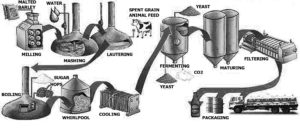| The diagram below shows the various stages involved in the production of beer.Summarise the information by selecting and reporting the main features, and make comparisons where relevant. |

[eBook available with all the common types of tasks for the Academic test…including maps and future predictions!]
Model answer for a process
The figure illustrates the different steps used to manufacture beer. Overall, there are eleven stages in the process, beginning with the milling of malted barley and ending with packaging the beer.
Looking at first stages of the process, we can see that in order to get liquid from malted barley, it has to be milled, mashed with water and lautered in special tanks. In order to get a pure liquid, the spent grain is taken out and used for feeding of animals. Then, the liquid has to be boiled with sugar and hops and mixed in a whirlpool before cooling.
In the next stages the cooled liquid has to be fermented by adding yeast and removing carbon dioxide. Then, it goes to storage tanks, in order to be matured. In the second to last stage, the matured beer is transferred to a filter for filtering. Finally, the beer is packed in bottles or barrels or put on trucks for delivery. [159 words]
Steps to plan a process diagram
1. Read the question and the process diagram and underline key words. Paraphrase key words where possible; and turn nouns into verbs, and verbs into nouns
The diagram below shows the various stages involved in the production
figure illustrates different steps used manufacture
of beer.
2. Look for any unlabeled parts of the process and name them if you can.
3. Look for a logical start point for the process.
Step one = Adding malted barley [top-left corner of the illustration] [top-left corner of the illustration]
4. Look for a logical middle point for the process, so that you can separate the data into paragraphs in the body of the report
step eight when the fermenting process begins
5. Look for the logical end point for the process.
Step 11 packaging
6. Number steps in the process to make sure you will not miss out any of the steps when you write your report.

7. Write the report
8. Proofread the report
[eBook available with all the common types of tasks for the Academic test…including maps and future predictions!]

